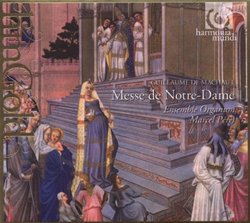| All Artists: Gregorian Chant, Guillaume de Machaut, Marcel Peres, Ensemble Organum, Malcolm Bothwell, Jean-Etienne Langianni, Antoine Sicot, Jerome Casalonga Title: Machaut: Messe de Notre-Dame Members Wishing: 1 Total Copies: 0 Label: Harmonia Mundi Fr. Release Date: 9/9/2008 Album Type: Import Genre: Classical Styles: Opera & Classical Vocal, Historical Periods, Early Music Number of Discs: 1 SwapaCD Credits: 1 UPC: 794881854523 |
Search - Gregorian Chant, Guillaume de Machaut, Marcel Peres :: Machaut: Messe de Notre-Dame
 | Gregorian Chant, Guillaume de Machaut, Marcel Peres Machaut: Messe de Notre-Dame Genre: Classical |
Larger Image |
CD Details |
CD ReviewsCorsican braying meets shoddy musicology Maddy Evil | London, UK | 12/01/2009 (2 out of 5 stars) "More than 10 years after its original release in 1996, this reading of Machaut's renowned "Messe de Notre-Dame" remains as provocative and as disturbing as ever. Diametrically opposed to the Oxbridge purity of renditions by groups such as the Taverner Consort and the Oxford Camerata (who add almost nothing to the original manuscript), Marcel Pérès claims in the liner notes that certain "fundamental elements" have been hitherto ignored in performances of Machaut's work, notably concerning pitches, ornamentation and vocal timbre. In short, "the performer should not be satisfied with merely reading a text and reproducing it", because, "what is notated down on the page is not the end result but the point of departure". Although these assertions strongly imply a detailed knowledge of contemporary theorist's writings (such as Hieronymous de Moravia, "Tractatus de Musica", c.1272-1300), unfortunately, a deeper understanding of these works, combined with knowledge of the real source for Pérès's "vocal timbre", raise serious doubts as to the supposed historical validity of his conclusions.
First and foremost, medieval theorists who expound on issues relating to vocal style and "florificatio vocis" (i.e. ornamentation) do so without exception predominantly in relation to chant - many do not even mention polyphonic music at all. Secondly, it is hardly insignificant that the vast majority of theorists advocating such a florid manner of chant singing actually predate Machaut, and in fact some of his contemporaries (such as Johannes de Muris, "Musica Speculativa", writing in 1323) even begin to speak out against certain types of ornamentation. Thirdly, the manuscripts containing polyphonic music also provide compelling evidence against liberal use of ornaments, both in terms of their complex notation and in their lack of nuances and graces (etc.) which are found in some chant repertories. Lastly, it should not be forgotten that contemporaries would have seen intricate polyphonic works (like Machaut's "Messe de Notre Dame") as already being "ornamental" from a liturgical perspective - indeed, only a few, isolated sections of Machaut's work are even vaguely suggestive of being potentially suitable for additional embellishment (e.g. at the words "ihesu christe" in the Gloria). In sum, to my knowledge, no single extant medieval source - be it theoretical treatise, manuscript, or otherwise - supports the relentless, indiscrimate application of ornamentation which is so shamelessly on display here. Yet if the use of excessive ornamentation is questionable, the inspiration for Pérès's "vocal timbre" is perhaps even more alarming. Contrary to the oft-held belief that this results from a generalised synthesis of Eastern singing techniques (see below, *1), the real model, to anyone familiar with it, is quite unmistakable - namely, that of Corsican polyphony (see below, *2). This in turn raises yet more questions: firstly, to what extent is a living, 20th-century oral tradition related to a 14th-century written one...? Why base an imagined "medieval" sound image exclusively on Corsica...? Why not superimpose vocal techniques from, say, Georgian polyphony or Coptic chant (etc) as well/instead...? (see below, *3). Even if it would be unwise to believe that an Oxbridge sound has authoritative claims to historical veritas, it is somewhat naive to attack such assumptions with a theory that is both illogical and impossible to justify (see below, *4). Instead, this rendition just sounds like yet another excuse for medieval exotica, which, incidentally, is merely exacerbated by Pérès's bohemian application of musica ficta (resulting in augmented and diminished intervals a plenty, and as a whole, clearly against the writings of contemporary theorists who discuss the rules of counterpoint). Perhaps, looking at it positively, we should be grateful to Pérès for challenging ingrained perceptions and for making us approach this familiar work in a new way. Unfortunately, however, it must be admitted that the end result is both as unsuccessful and as unhistorical as the recording of Palestrina: Missa Primi Toni sung by the Bulgarian choir Ensemble Bulgarka Jr (Erato Detour 3984-20030-2, recorded 1997). (*1) - c.f. for example some of the customer reviews (on amazon) for the original issue of this recording, etc. (*2) - c.f. with "Voci di Corsica - Polyphonies" (Editions Olivi Music, OVI 45204-2, recorded 1993), etc. (*3) - the potential counterargument to this, that Corsican polyphony has more relationship to France than other oral traditions, is clearly undermined if one takes into account the fact that Corsica was only annexed to France in 1770, by which time Machaut had been dead for the best part of 400 years. (*4) - whilst the vocal ideal described by some theorists could be taken to suggest a correlation with certain elements found in Eastern singing techniques (regarding ornamentation, articulation demands, liquescent slides, pulsation, etc.), it must be stressed that, once again, these observations are made in relation to monophony and semi-improvised polyphony and NOT written polyphony; furthermore, they come from sources predating Machaut by some distance - in some cases, hundreds of years. The case for a full-on Eastern singing style in late medieval polyphonic works (such as Machaut's Messe de Notre Dame) is without foundation. " |
